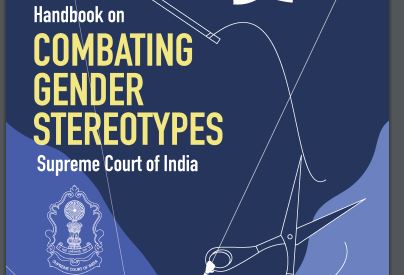Handbook on combating gender stereotypes pdf
the Supreme Court introduced Handbook on Combating Gender Stereotypes focused on countering gender stereotypes. This resource is intended to offer guidance to judges, assisting them in refraining from the use of unsuitable gender-related language in court orders and legal paperwork.
This Handbook on Combating Gender Stereotypes aims offers guidance on how to avoid utilising harmful gender stereotypes, in particular those about women, in judicial decision making and writing. Each one of us sometimes employ stereotypes in our thoughts, words, and actions. We may rely on stereotypes inadvertently, because stereotypes are often internalised and ingrained in our thinking due to societal, cultural, and environmental conditioning. This can make it difficult to identify and avoid relying on stereotypes. However, challenging and overcoming stereotypes is essential to ensuring an equal, inclusive, and compassionate society.
Handbook on Combating Gender Stereotypes words LIst
| Stereotype promoting language (INCORRECT) | Alternative language (PREFERRED) |
|---|---|
| Adulteress | Woman who has engaged in sexual relations outside of marriage |
| Affair | Relationship outside of marriage |
| Bastard | Non-marital child or, a child whose parents were not married |
| Biological sex / biological male / biological female | Sex assigned at birth |
| Born a girl / boy | Assigned female / male at birth |
| Career woman | Woman |
| Carnal intercourse | Sexual intercourse |
| Chaste woman | Woman |
| Child prostitute | Child who has been trafficked |
| Concubine / keep | Woman with whom a man has had romantic or sexual relations outside of marriage |
| Dutiful wife / Faithful wife / Good wife / Obedient wife | Wife |
| Easy virtue (e.g., a woman of easy virtue) | Woman |
| Effeminate (when used pejoratively) | Accurately describe the characteristic using a gender neutral term (e.g., confident or responsible) |
| Eve teasing | Street sexual harassment |
| Faggot | Accurately describe the individual’s sexual orientation (e.g., homosexual or bisexual) |
| Fallen woman | Woman |
| Feminine hygiene products | Menstrual products |
| Forcible rape | Rape |
| Harlot | Woman |
| Hermaphrodite | Intersex |
| Hooker | Sex worker |
| Hormonal (to describe a woman’s emotional state) | Use a gender neutral term to describe the emotion (e.g., compassionate or enthusiastic) |
| Housewife | Homemaker |
| Indian woman / western woman | Woman |
| Ladylike | Use a gender neutral description of behaviour or characteristics (e.g., amusing or assertive) |
| Layabout / Shirker | Unemployed |
| Marriageable age | A woman who has attained the legal age required to marry |
| Prostitute | Sex worker |
| Provider / Breadwinner | Employed or earning |
| Provocative clothing / dress | Clothing / dress |
| Ravished (e.g., she was “ravished” by him) | Sexually harassed / assaulted or raped |
| Seductress | Woman |
| Sex change | Sex reassignment or gender transition |
| Slut | Woman |
| Spinster | Unmarried woman |
| Survivor or Victim? | An individual who has been affected by sexual violence may identify themselves as either a “survivor” or “victim”. Both terms are applicable unless the individual has expressed a preference, in which case the individual’s preference should be respected. |
| Transsexua | Transgender |
| Transvestite | Cross-dresser |
| Unwed Mother | Mother |
| Violated (e.g., he violated her) | Sexually harassed / assaulted or raped |
| Whore | Woman |
The Handbook on Combating Gender Stereotypes aims to assist judges and the legal community in identifying, understanding and combating stereotypes about women. It contains a glossary of gender-unjust terms and suggests alternative words or phrases which may be used while drafting pleadings as well as orders and judgments. The Handbook identifies common stereotypes about women, many of which have been utilised by courts in the past and demonstrates why they are inaccurate and how they may distort the application of the law. The intention is not to criticise or cast doubt on past judgements but merely to show how stereotypes may unwittingly be employed. Finally, it encapsulates the current doctrine on key legal issues which may be relevant while adjudicating certain cases, particularly those concerning sexual violence.
Handbook on combating gender stereotypes pdf Handbook on combating gender stereotypes pdf





